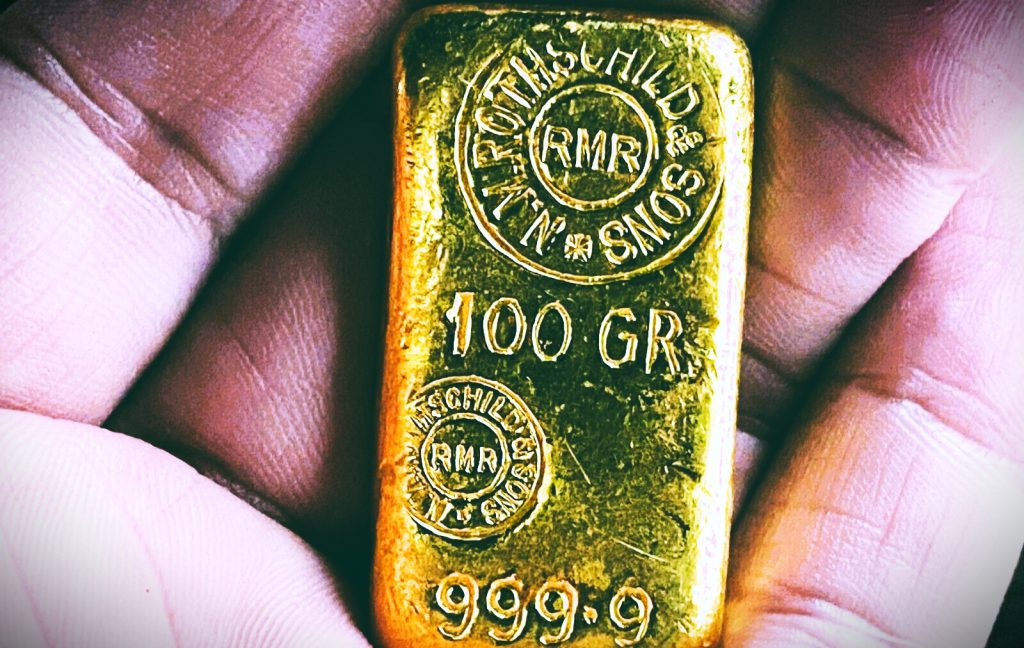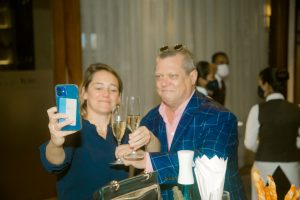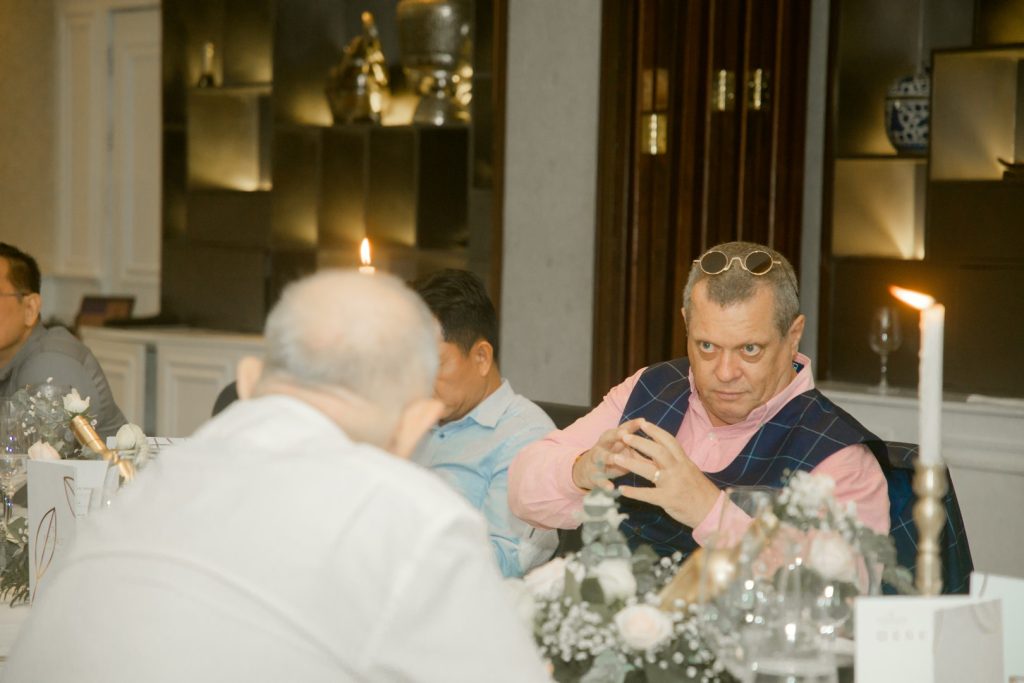In 1868, Baron James de Rothschild of what was to become known as the ‘French branch’ of the Rothschild family purchased the Medoc estate, Chateau Lafite. This was 15 years after his son-in-law, Baron Nathaniel de Rothschild purchased Chateau Brane Mouton, in Bordeaux and renamed it, Chateau Mouton Rothschild. Thus commenced the family’s dedication to the wine industry, a passion that has become the stuff of legend and continues on to this day.
James’s great-grandson, Baron Edmond de Rothschild furthered the family’s wine endeavors, when in 1973 he purchased Chateau Clarke, (Listrac) and Chateau Malmaison (Moulis-en-Medoc). Then, in 1997 the family entered into a partnership with the Rupert family in South Africa to acquire the Friedrickburg Estate in Franschhoek, and just one year later formed another group of investors and founded Clos de los Siete in the Uco Valley, (Argentina) to produce the wine Flechas de los Andes.
The family then acquired Chateau des Laurets and Chateau de Malengin in Saint-Émilion, (France) in 2003, and joined other members of the Rothschild family in the creation of the Champagne ‘Barons de Rothschild’. In 2012, twenty-four hectares of vineyards were purchased in Marlborough, New Zealand to produce wines under the Rimapere label. In the indigenous Maori language, rimapere means five arrows, which for the Rothschilds represents the family shield, one arrow for each of the five brothers at the origin of this dynasty of great entrepreneurs.
 The company then expanded into Spain, (in partnership with Vega Sicilia) with the 2017 launch of the winery ‘Bodega Benjamin de Rothschild Y Vega Sicilia – Macán’ in Rioja, and the opening of the hotel Palacio de Samaniego in Rioja Alavesa, in 2021.
The company then expanded into Spain, (in partnership with Vega Sicilia) with the 2017 launch of the winery ‘Bodega Benjamin de Rothschild Y Vega Sicilia – Macán’ in Rioja, and the opening of the hotel Palacio de Samaniego in Rioja Alavesa, in 2021.
Today, the company, Baron Edmond de Rothschild Heritage combines the non-banking, lifestyle assets owned by the Edmond de Rothschild Group, including wine, hospitality, restaurants, and farming. The wineries owned by Edmond de Rothschild Heritage produce some 3.5 million bottles of wine each year.
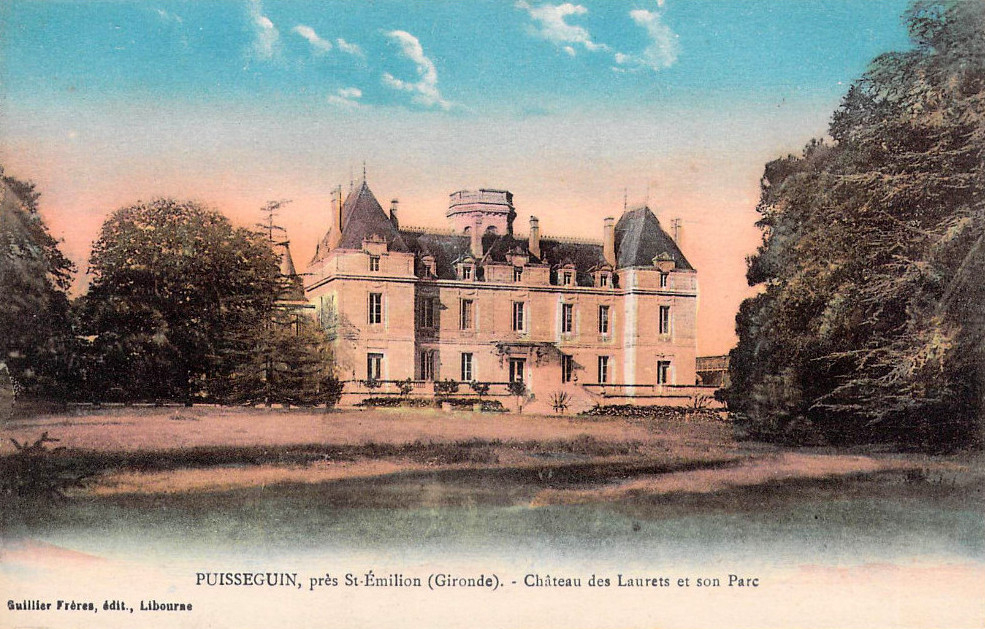 On the special occasion of a visit to Cambodia by Amélie Duboc, Asia Pacific Export Manager for Edmond de Rothschild Heritage, Thalias Hospitality Group invited Amélie to present some of the highlights of her portfolio to their management and service teams, over a magnificent dinner at Topaz restaurant. Topaz is renowned as the French Jewel in Cambodia’s culinary crown, and was recently voted into the prestigious list of Asia’s Top 100 Restaurants.
On the special occasion of a visit to Cambodia by Amélie Duboc, Asia Pacific Export Manager for Edmond de Rothschild Heritage, Thalias Hospitality Group invited Amélie to present some of the highlights of her portfolio to their management and service teams, over a magnificent dinner at Topaz restaurant. Topaz is renowned as the French Jewel in Cambodia’s culinary crown, and was recently voted into the prestigious list of Asia’s Top 100 Restaurants.
 After a delightful welcome drink of Champagne in the tranquil garden, the group moved inside for what promised to be an exciting degustation and wine tasting.
After a delightful welcome drink of Champagne in the tranquil garden, the group moved inside for what promised to be an exciting degustation and wine tasting.
Ms. Duboc is a warm and captivating presenter, who charmed guests with her knowledge of the wines and the history and complex family tree of the Rothschild empire.
The first wine was a Right Bank Bordeaux from an exceptional vintage; the Chateau des Laurets, from Puisseguin, Saint Emilion. The Chateau was built in 1860 and is noticeable for its octagonal tower, which looks out over the grounds. The wine is a blend of 80% Merlot and 20% Cabernet Franc, the vines are grown in excellent clay and limestone soils.
Cold soaking and then fermentation took place in oak and stainless-steel vats with automatic temperature control. Post-fermentation the wine underwent micro-oxygenation during maceration followed by malolactic fermentation in oak and stainless-steel vats. Maturation was 14 months in 30% new barrels, 30% second fill barrels, and the rest in vats. The alcohol comes in at a very healthy 14.5%.
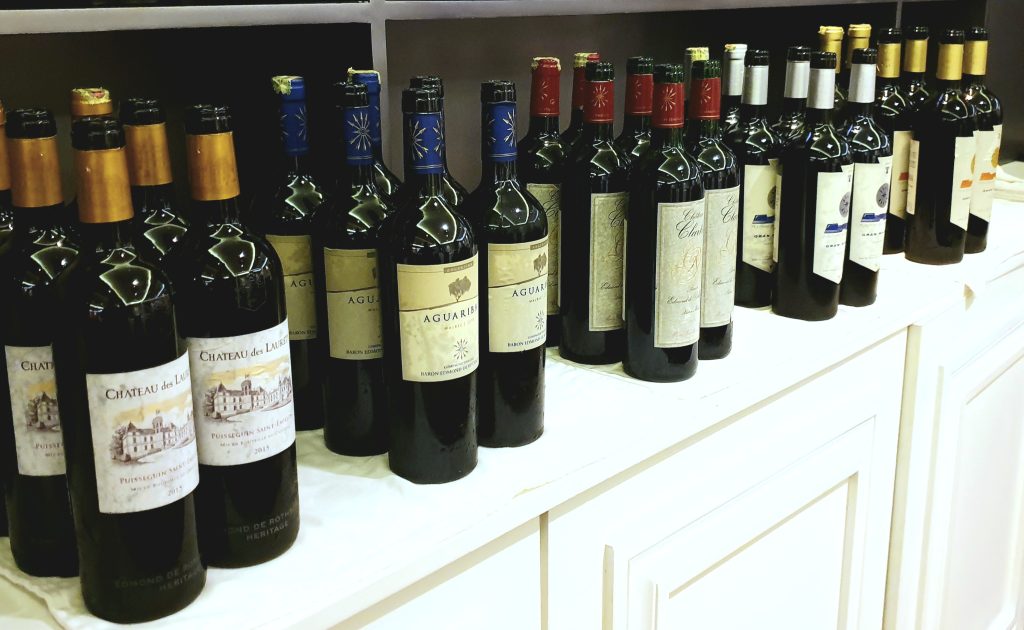 2015 is universally regarded as an exceptional vintage in Bordeaux and especially on the right bank which houses Saint Emilion, I have enjoyed wines from this vintage for many years now and found the Chateau des Laurents to be drinking absolutely beautifully.
2015 is universally regarded as an exceptional vintage in Bordeaux and especially on the right bank which houses Saint Emilion, I have enjoyed wines from this vintage for many years now and found the Chateau des Laurents to be drinking absolutely beautifully.
Deep ruby in colour, with aromas of forest berries, (mulberry, logan-berry, Boysen-berry) and wild violets, complimented by hints of vanilla, cooking chocolate, and coffee grinds. The palate shows ripe, generous fruit, with good intensity and concertation of flavours. The tannins are very fine -like satin- giving the wine a silky mouthfeel. The fruit flavours are fresh and vibrant, lingering attractively on the back palate. At peak drinking and a great way to start -this was going to be a hard wine to top for the rest of the evening.
The dish: an exquisite grilled Mekong lobster with a beurre blanc sauce.
 The next wine was the Aguaribay Malbec 2018, Uco Valley, Argentina. The Aguaribay tree, (also known as the ‘false-pepper tree’ or Schinus Molle) is something of an emblem in the area and the label is from Baron Edmond Rothschild owned Flechas de los Andes winery.
The next wine was the Aguaribay Malbec 2018, Uco Valley, Argentina. The Aguaribay tree, (also known as the ‘false-pepper tree’ or Schinus Molle) is something of an emblem in the area and the label is from Baron Edmond Rothschild owned Flechas de los Andes winery.
A straightforward, fruit-driven Malbec, with good weight and power, the fruit is ripe, juicy, and straight ahead with plum, black cherry, leather, roasted nuts, and spice. A bargain hunter’s Malbec and a good asado accompaniment.
The dish: baked Burgundy escargots in garlic, parsley, and butter.
We then moved back to Bordeaux, the Left Bank this time, (Listrac-Medoc) for the Chateau Clarke 2011. The vineyard has a long history, dating all the way back to the 12th century when Cistercian monks of the Vertheuil Abbey planted the first vines here. The chateau takes its name, (Clarke) from the Irish family, (Tobias Clarke) who purchased the property in the 18th century.
After more than two centuries of wine-growing tradition and successive owners, the property was purchased by Baron Edmond de Rothschild in 1973. Whilst a majority shareholder in Chateau Lafitte, Baron Edmond saw this property as his own personal adventure and had a great affection for this site and an unbounded belief in its potential. The Baron wanted it to be his masterpiece and the vineyard was completely redeveloped and replanted; followed by massive investment to restore and renovate buildings and improve the winemaking and storage facilities on the property.
Baron Edmond de Rothschild brought in such esteemed consultants as Emile Peynaud and then Michel Rolland, (who continues to advise on the vineyard management and winemaking for the estate to this day). The Baron’s legacy here is that the wines of Chateau Clarke are generally thought to be the very finest in this sub-region, an achievement he would be immensely proud of.
Following the death of Edmond de Rothschild the estate was inherited by his son, Benjamin de Rothschild, and Ariane de Rothschild, and such was Baron Edmond’s passion for this estate and its achievements, he chose Château Clarke as his last resting place and is buried in the grounds of the chateau.
 In a region famous for Cabernet Sauvignon, the soil profile of this vineyard and the average temperatures of the sub-region are more suited to Merlot, and so a planting mix favoring the variety was undertaken. The wine is 70% Merlot and 30% Cabernet Sauvignon; after vigorous selection and sorting, the must is fermented in large vats and matured in predominantly new oak for 14 to 18 months.
In a region famous for Cabernet Sauvignon, the soil profile of this vineyard and the average temperatures of the sub-region are more suited to Merlot, and so a planting mix favoring the variety was undertaken. The wine is 70% Merlot and 30% Cabernet Sauvignon; after vigorous selection and sorting, the must is fermented in large vats and matured in predominantly new oak for 14 to 18 months.
Crimson in colour with complex aromas of sweaty saddle, damp earth, cedar, tobacco leaf, cigar box, prune, plum, dried herbs, mocha, and a hint of spice. I’ve had many Chateau Clarkes that were much better, unfortunately, this one comes from a tough-to-love vintage for Bordeaux, (2011). This bottle looks a little past its best tonight, but it’s hanging in gamely. Tannins are very fine, the fruit supple and complex, the wine very dry, with fruit that is complex and well-balanced.
The dish was a magnificent pig’s trotter with morel mushrooms and foie gras.
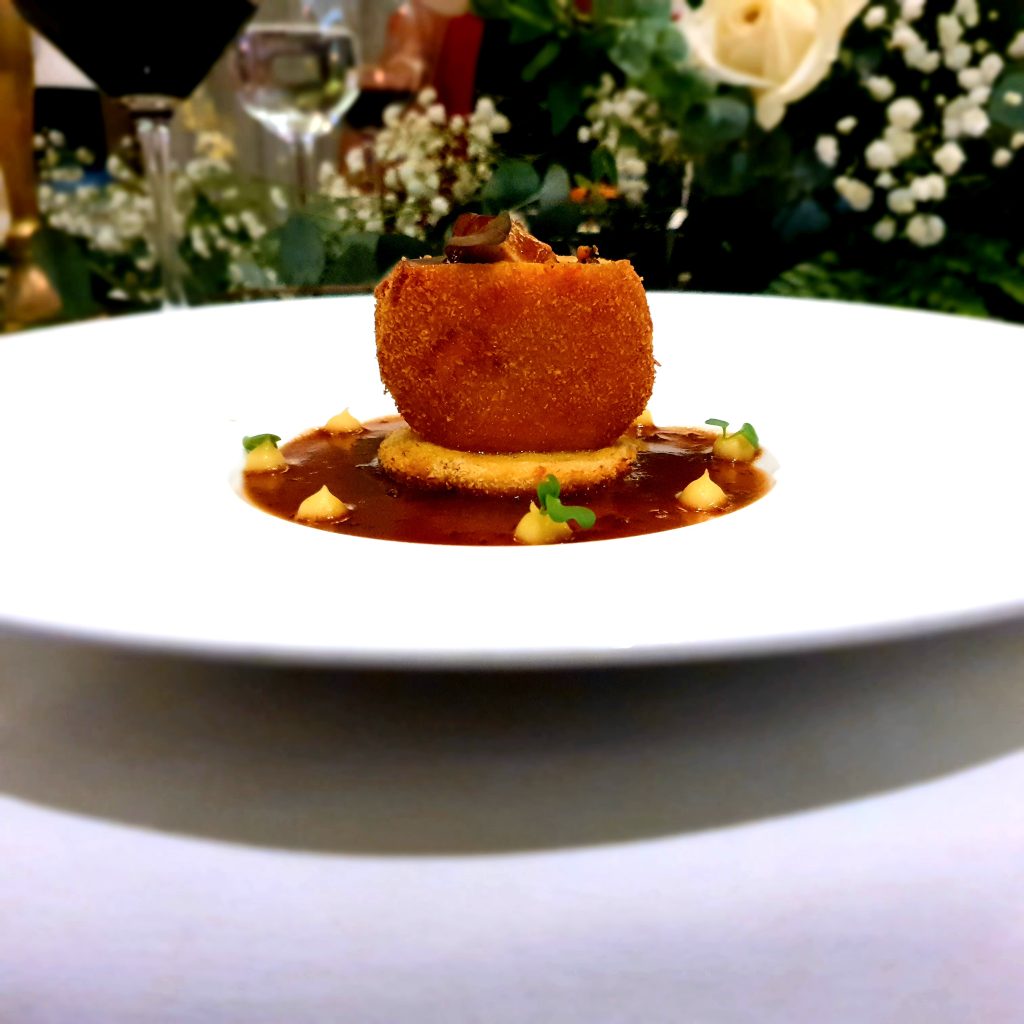 We then moved to South America for the Flechas de los Andes Gran Malbec, Uco Valley, Argentina 2014. The name “Flechas de Los Andes” or “Andes arrows” refers to the 5 arrows, represented on the label and the symbol of the Rothschild family.
We then moved to South America for the Flechas de los Andes Gran Malbec, Uco Valley, Argentina 2014. The name “Flechas de Los Andes” or “Andes arrows” refers to the 5 arrows, represented on the label and the symbol of the Rothschild family.
Planted in the crisp, cool air at 1100 meters above sea level, in the gravel-strewn alluvial terrain at the base of the Andes cordillera. The grapes are handpicked and hand-sorted, bunches are destemmed and then fermentation takes place in large, stainless-steel tanks. Malo-lactic conversion and maturation use the ‘thirds’ rule to obtain oak-fruit-structure balance: one-third in new French oak, one-third in second-fill oak, and one-third in tank for 12 to 18 months.
 Dark ruby in colour with a glowing magenta rim, the wine is big and brooding with aromas of plum, cherry, cola, cocao, vanilla, pan spices, and saddle leather. Bold fruit flavours of plum and cherry flood the palate and seep into the corners of your mouth, before more complex notes of spice and tar come to the fore, with hints of dark chocolate and licorice adding complexity. Tannins are soft and subtle, with some bright acidity and clean ripe fruit lingering on the finish. A very fine Argentinian Malbec indeed.
Dark ruby in colour with a glowing magenta rim, the wine is big and brooding with aromas of plum, cherry, cola, cocao, vanilla, pan spices, and saddle leather. Bold fruit flavours of plum and cherry flood the palate and seep into the corners of your mouth, before more complex notes of spice and tar come to the fore, with hints of dark chocolate and licorice adding complexity. Tannins are soft and subtle, with some bright acidity and clean ripe fruit lingering on the finish. A very fine Argentinian Malbec indeed.
The dish was a superb roasted lamb rack and glazed spring vegetables and a lamb jus with mint.
 The final wine of the night was to be the Flechas de Los Andes ‘Gran Corte’ 2015, Vista Flores, Uco Valley, Argentina. The is a blend of 55% Malbec, 40% Cabernet Franc, and 5% Shiraz/Syrah, the wine is matured in new French oak for 24 months. This strikes one as an opulent, majestic wine -the collaboration between Baron Benjamin de Rothschild and Laurent Dassault culminating in the creation of this exceptional blend. With its heart in the clouds -high up in the Andes mountains, and its head somewhere in the great growths of the Medoc, Bordeaux, this wine was simply stunning.
The final wine of the night was to be the Flechas de Los Andes ‘Gran Corte’ 2015, Vista Flores, Uco Valley, Argentina. The is a blend of 55% Malbec, 40% Cabernet Franc, and 5% Shiraz/Syrah, the wine is matured in new French oak for 24 months. This strikes one as an opulent, majestic wine -the collaboration between Baron Benjamin de Rothschild and Laurent Dassault culminating in the creation of this exceptional blend. With its heart in the clouds -high up in the Andes mountains, and its head somewhere in the great growths of the Medoc, Bordeaux, this wine was simply stunning.
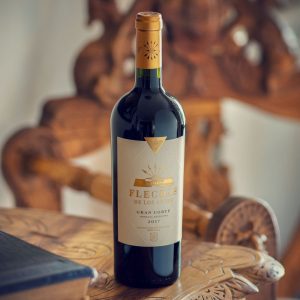 Dense ruby in colour with crimson hues, the wine is powerful, complex and yet silky and seductive, with aromas of blueberry, dark chocolate, spices, and vanilla. The palate is rich, powerful, complex and graceful with dark fruits and forest berries, field herbs and spices, tobacco leaf, coffee grinds, dark chocolate, and vanilla pods. There is excellent length here, tannins are persistent yet fine and supple, fruit flavours linger for an age on the back palate.
Dense ruby in colour with crimson hues, the wine is powerful, complex and yet silky and seductive, with aromas of blueberry, dark chocolate, spices, and vanilla. The palate is rich, powerful, complex and graceful with dark fruits and forest berries, field herbs and spices, tobacco leaf, coffee grinds, dark chocolate, and vanilla pods. There is excellent length here, tannins are persistent yet fine and supple, fruit flavours linger for an age on the back palate.
The first glass of the evening, a magnificent 2015 Bordeaux, was always going to be hard to beat, but this coda, a wine of incredible vision and scope, may just have knocked it over; the wine was epic and I loved it.
Served with a baked Brie de Meaux with fresh black winter truffles.
 The team from Thalias were impressed and appreciative in equal measure, as was this wine critic. Amélie Duboc’s company had been both illuminating and enjoyable, the food from Topaz was, once again exceptional, and the wines were a revelation, a couple of them absolutely outstanding. This all elevated the evening beyond the realms of a mere trade visit and wine tasting, this was a memorable degustation of food, wine, and company, that the team will remember with great joy, for a long time to come.
The team from Thalias were impressed and appreciative in equal measure, as was this wine critic. Amélie Duboc’s company had been both illuminating and enjoyable, the food from Topaz was, once again exceptional, and the wines were a revelation, a couple of them absolutely outstanding. This all elevated the evening beyond the realms of a mere trade visit and wine tasting, this was a memorable degustation of food, wine, and company, that the team will remember with great joy, for a long time to come.

